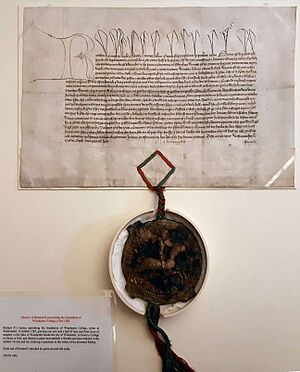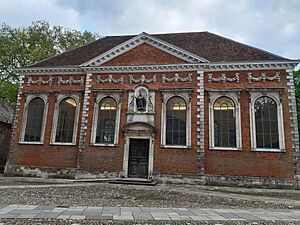History of Winchester College facts for kids
Winchester College is a famous school in England with a long and interesting history. It was founded way back in 1382 by a man named William of Wykeham. He was a very important person, serving as a Bishop of Winchester and also working for two kings, Edward III and Richard II.
William of Wykeham decided to start this school because there weren't enough trained priests after a terrible sickness called the Black Death. Winchester College was meant to be a special "feeder" school. It would teach boys Latin grammar and prepare them for New College at Oxford University, which William of Wykeham also founded.
Just like other schools from that time, Winchester College taught everything in Latin. Students had to speak, read, and write in Latin. This was very common for a long time, as Latin was the main language for learning and discussions at universities until the 1700s.
Contents
Starting the School
William of Wykeham set up Winchester College with two main goals: religious and educational. He made sure there were funds for special prayers to be said for his soul. Three chaplains, three clerks, and sixteen choristers had a lot of prayers and services to perform.
Two masters were in charge of teaching the students. Ten fellows and the warden looked after both the religious and educational parts of the school. William of Wykeham left a lot of money and land to make sure the school would last a long time. This money helped support the 70 scholars and all the staff.
The school's official name, from its 1382 charter, is in Latin: Collegium Sanctae Mariae prope Wintoniam. This means "St Mary's College, near Winchester." New College in Oxford was also named after St. Mary. This shows how important religion was to both the school and the university. New College would teach Winchester's students about religion and law, also in Latin.
The first 70 "poor scholars" started at the school in 1394. To get in, boys needed to know some basic Latin grammar. Most of their time at Winchester was spent getting really good at Latin. The school had a strict rule: only Latin was to be spoken "in hall." This was different from older schools that allowed both French and Latin. It shows that French was becoming less important.
In the early 1400s, scholars had to come from families earning less than five marks sterling a year. To give you an idea, a normal living for a yeoman (a farmer who owned his land) at that time was about £5 a year.
Winchester College also had new ideas for discipline. They used older students, called prefects, to help keep order. The rules said that discipline should be less harsh than in other medieval schools. Winchester was also special because it taught boys aged 12 to 18. Universities would accept students in this age range too.
These new ideas, including having a school linked to a university, became a model for Eton College and King's College, Cambridge. These schools were founded about 50 years later. Eton and Winchester became very close partners during this time.
At first, only a few students who weren't scholars were allowed. By the 1400s, the school had about 100 students in total. These included the 70 scholars, 16 choirboys (called "quiristers"), and the rest were "commoners." Many people wanted their sons to be commoners, and their numbers slowly grew over time.
The Early Modern Period
Because Winchester College was a religious school, it faced problems during the reign of King Henry VIII. In 1535, officials visited the college to check its wealth. Some of Winchester's valuable land near London was taken by the king. The school got other land in exchange, but it lost a lot of its wealth.
In 1545, a plan was made to take all of Winchester College's assets and close the school. This plan was stopped only because King Henry VIII died. His son, Edward VI, quickly changed direction. Edward said that worship and Bible readings should be done in English, not Latin.
During the reigns of Henry, Edward, Elizabeth, and James, kings and queens would visit the school. Students would perform Latin and some Greek poems for them. Queen Elizabeth also allowed Winchester, Eton, and other schools to continue their religious services in Latin. This helped students improve their language skills.
One of the school's best Latin scholars from this time was Christopher Johnson. He was praised by others for his work. He was a student and later a headmaster at the college. His poems tell us a lot about daily life at the school back then. He even wrote a poem about being a student at Winchester. Writing Latin poetry was a common part of Latin education. An English poet, lawyer, and politician named John Davies also went to the school.
Both Queen Elizabeth and King James used the school for their own purposes. Elizabeth tried to force her own choices for staff onto the school. King James ordered the school to provide rooms for judges. These judges were there to try Sir Walter Raleigh for treason in the town's courts.
The college also had disagreements with church leaders during the reigns of James and Charles. In 1608, Archbishop Bancroft made rules against unfair practices, like favoring relatives when choosing students. He also demanded that teachers stop asking for extra payments from students. In 1635, Archbishop William Laud was worried about the school's Puritan religious ideas. He ordered that religious services at Winchester be performed fully. He also said the altar in the chapel should face north-south, at the east end.
At the start of the English Civil War, Winchester and the area around it supported the King. When Parliament's forces took over the town in autumn 1645, they damaged many buildings, including the cathedral. But the school avoided serious damage. The earlier religious disagreements with Archbishop Laud might have helped the school deal with Parliament's forces.
From Victorian Times to Today
Starting in the 1860s, ten new boarding houses were built. Each house could hold up to sixty students. This greatly increased the number of students the school could have. By 2020, the school had grown to 690 students. Since 2022, Winchester College has also started accepting day students in the Sixth Form, including girls.
Sources
- Custance, Roger, (ed.), Winchester College: Sixth Centenary Essays, Oxford: Oxford University Press, 1982
- Dilke, Christopher, Dr Moberly's Mint-Mark: A Study of Winchester College, London: Heinemann, 1965
- Fearon, William A., The Passing of Old Winchester: Winchester: Winchester College, 1924
- Firth, J. D'E., Winchester College, Winchester: Winchester Publications, 1949
- Kirby, T. F., Annals of Winchester College, London and Winchester: Henry Frowde, 1892
(Review)
- Mansfield, Robert, School Life at Winchester College, London: John Camden Hotten, 1866
- Rich, Edward J. G. H., Recollections of the Two St. Mary Winton Colleges, Walsall and London: Edward Rich, 1883
- Stevens, Charles, Winchester Notions: The English Dialect of Winchester College, London: Athlone Press, 1998
- Tuckwell, William, The Ancient Ways: Winchester Fifty Years Ago, London: Macmillan, 1893
- Walcott, Mackenzie E. C., William of Wykeham and his Colleges, London: David Nutt, 1852
- Wordsworth, Charles, The College of St Mary Winton near Winchester, Oxford and London: J. H. Parker, 1848
Education and Neo-Latin literature




